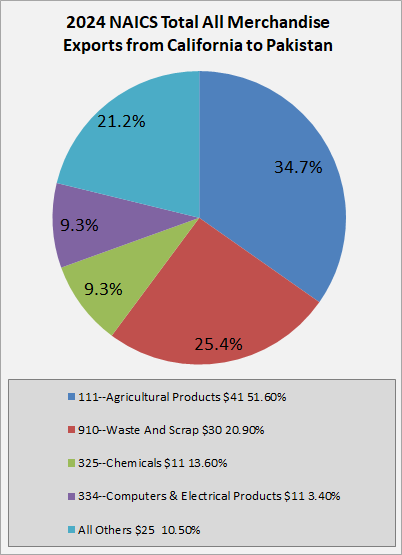Trading Partner Portal: Pakistan
Overview
Pakistan and US reach a trade agreement to develop oil reserves and reduce tariffs
The Associated Press, July 31, 2025
Further Modifying the Reciprocal Tariff Rates
The White House, July 31, 2025
Trade Overview
 Pakistan is a south Asian, mixed economy country, bordering the Arabian Sea with India to the east, China to the north and Iran and Afghanistan to the west.
Pakistan is a south Asian, mixed economy country, bordering the Arabian Sea with India to the east, China to the north and Iran and Afghanistan to the west.
The land-area of what is modern-day Pakistan is one of the oldest land areas of human activity, with the earliest civilizations settling there almost 5,000 years ago. Pakistan’s total population is roughly 251.27 million, with GDP totaling $373.07 billion in 2024. World Bank
It is a mostly hot, dry desert, with its northern area having colder temperatures, and the northeast being more temperate. It notably has extensive natural gas reserves, mineral deposits and arable land. Its most notable economic industries are textiles, food processing, paper products, fertilizers, and construction materials. CIA Factbook
U.S. – Pakistan Trade
The U.S. is one of Pakistan’s largest trading partners and continues to be one of the country’s largest sources of foreign direct investment. Two-way trade in goods between the two countries totaled $7.23 billion in 2024, with total exports from the U.S. to Pakistan being $2.11 billion. Top exports included agricultural products ($817 million), waste and scrap ($454 million), chemicals ($154 million), non-electrical machinery ($112 million), and transportation equipment ($107 million). U.S. Department of Commerce
Imports from Pakistan to the U.S. totaled $5.12 billion in this same year. Top imports were apparel and accessories ($2.32 billion), textile mill products ($1.45 billion), miscellaneous manufactures ($382 million), textiles and fabrics ($213 million), and processed foods ($184 million).
Pakistan – California Trade

California is a top goods exporter to Pakistan, being ranked 4th out of all U.S. states. California exported a total of $118 million to Pakistan, with agricultural products being the top export at $41 million. This was followed by waste and scrap ($30 million), chemicals ($11 million), computer & electronic products ($11 million), and processed foods ($8 million).
California is a top importer of Pakistani products. In 2024, California imported $594 million in goods, with the top import being apparel & accessories ($233 million), textile mill products ($129 million), chemicals ($87 million), miscellaneous manufactures ($45 million), and processed foods ($26 million).
FDI – Pakistan
The U.S. direct investment position in Pakistan was $251 million in 2024, a decrease of 50.3% from 2023. The direct investment position from Pakistan in the United States was $110.0 million, an increase of 4.8% from 2023.
Current data shows that Pakistan-based majority-owned affiliates of U.S. MNEs sales were $2.7 billion, while U.S.-based majority-owned affiliates of Pakistan MNEs employed 0.70 thousand people.
Trade Agreements
Trade Agreements
Pakistan is active in trade across the world, with multiple free trade agreements, preferential agreements, and bilateral tax treaties. It is also a member of multiple trade organizations and international trading associations. Pakistan is a member of the WTO, the South Asian Association for Regional Cooperation (SAARC), and has GSP Plus status with the EU.
Most recently in July of 2025, Pakistan reached a trade deal with the Trump administration, with a key part of the deal being about the oil reserves Pakistan holds and reducing tariff rates declared on what President Trump called ‘Liberation Day’ on April 2, 2025.
Bilateral Investment Treaty (BIT)
Pakistan and the U.S. had been negotiating a Bilateral Investment treaty from 2004-2012, the agreement remains closed but unsigned due to reservations from Pakistani stakeholders.
Pakistan has multiple bilateral investment agreements across the world, with these typically having dispute settlement provisions. These agreements are with Australia, Azerbaijan, Mauritius, Bahrain, Bangladesh, Morocco, Belarus, Netherlands, Belgo-Luxemburg Economic Union, Oman, Philippines, Bosnia, Portugal, Bulgaria, Qatar, Cambodia, Romania, China, Singapore, Czech Republic, South Korea, Denmark, Spain, Egypt, Sri Lanka, France, Sweden, Germany, Switzerland, Indonesia, Syria, Iran, Tajikistan, Italy, Tunisia, Japan, Turkey, Kazakhstan, Turkmenistan, Kuwait, U.A.E, Kyrgyz Republic, United Kingdom, Lebanon, Uzbekistan, Laos and Yemen.
Trade and Investment Framework Agreement (TIFA)
Th U.S. and Pakistan signed a Trade and Investment Framework Agreement in 2003 which gives a forum for discussion of bilateral trade issues. The last meeting was held in Islamabad in May 2019.
Free Trade Agreements (FTA)
Pakistan holds free trade agreements with China, Malaysia, and Sri Lanka. It is also a part of SAARC and has preferential trade agreements with Iran, Indonesia, Turkey, and Mauritius.
Bilateral Tax Treaties
Pakistan and the U.S. have had a bilateral tax treaty in force since 1958. It holds double taxation agreements Austria, Canada, Germany, Indonesia, Italy, Lebanon, Mauritius, Poland, Switzerland, Turkmenistan, Kazakhstan, the United Arab Emirates, Belgium, China, France, Greece, Iran, Japan, Libya, Saudi Arabia, Romania, Sweden, Belarus, Hungary, Jordan, Kenya, Kuwait, Malaysia, Netherlands, Nigeria, Norway, Oman, Philippines, Qatar, South Africa, Syria, Tunisia, Uzbekistan, the United Kingdom, Bangladesh, Denmark, Finland, India, Ireland, South Korea, Malta, Singapore, Sri Lanka, Thailand, Azerbaijan, and Turkey. U.S. Department of Commerce
Events
Events